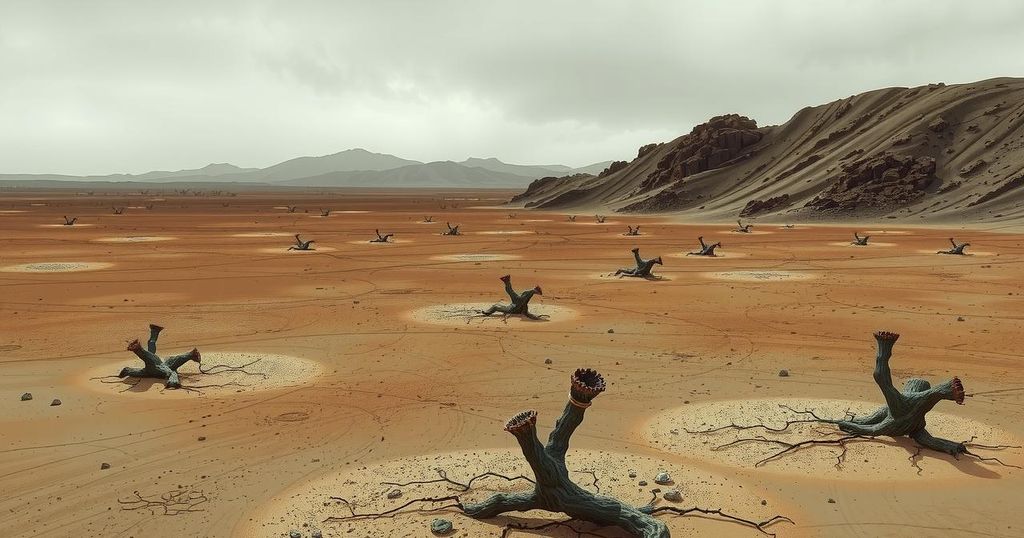Climate change
ASIA, AUSTRIA, CHRIS FIELDING, CLIMATE CHANGE, CONSERVATION, ECOLOGY, ENVIRONMENT, EUROPE, FRANK, GLOBAL WARMING, GREENHOUSE GAS EMISSIONS, GSA, HREN, IRELAND, JAPAN, NATURAL HISTORY MUSEUM OF VIENNA, SYDNEY BASIN, TRACY FRANK, UCONN, UCONN DEPARTMENT OF EARTH SCIENCES, UNIVERSITY COLLEGE CORK, UNIVERSITY OF CONNECTICUT, USA
Jamal Walker
0 Comments
Understanding Plant Resilience Post-End-Permian Event: Lessons for Today
Scientists from University College Cork, the University of Connecticut, and the Natural History Museum of Vienna have detailed how plants coped with major climate shifts 250 million years ago, during the End-Permian Event. Their research outlines the gradual recovery of ecosystems post-extinction, highlighting the shift from conifers to seed ferns and the long-term ecological impacts of extreme climate events, with crucial implications for current climate challenges.
A collaborative team of scientists from University College Cork, the University of Connecticut, and the Natural History Museum of Vienna have investigated how plants adapted to significant climate changes approximately 250 million years ago. Their research, published in the GSA Bulletin, illuminates the extended ecosystem recovery following the End-Permian Event, considered one of the most severe warming periods in Earth’s history.
The End-Permian Extinction, also referred to as the Great Dying, represents the most formidable ecological crisis within the past 500 million years. Tracy Frank, Professor and Department Head at UConn, explained that this event likely resulted in a five-fold increase in atmospheric CO₂, global temperature spikes exceeding 10°C, ozone layer depletion, rampant wildfires, and altered rainfall patterns worldwide.
This catastrophic event eradicated over 80% of ocean species, marking it as the worst mass extinction yet identified. However, the repercussions for terrestrial life materials remained less understood. Through the analysis of fossils and geological samples from the Sydney Basin in eastern Australia, researchers portrayed an extensive narrative of resilience and the prolonged impacts of climate change following this stark ecological downturn.
The findings indicate that conifers were among the initial vegetation to repopulate the land following the extinction event. However, their establishment faced hurdles due to a rise in temperatures during the Late Smithian Thermal Maximum, approximately three million years post-extinction, leading to their downfall. Tough, shrubby plants akin to modern clubmosses subsequently took over during this 700,000-year scorching interval, complicating the survival of larger plants.
Following a significant cooling period dubbed the Smithian-Spathian Event, a unique group of large plants named “seed ferns” began to proliferate and cultivate stable forests. These plants dominated terrestrial landscapes for millions of years, facilitating the emergence of the lush forests that characterized the Mesozoic era, known as the age of dinosaurs.
Chris Fielding remarked that the post-apocalyptic flora were predominantly opportunistic, akin to current-day weeds. This initial vegetation was primarily small and sparsely distributed, while the establishment of larger trees took extensive time as environmental conditions gradually improved.
Ultimately, the Mesozoic forests resembled pre-collapse ecosystems, but the species present were notably different. Chris Mays, leader of the Mass Extinction Group at University College Cork, stated, “the term ‘recovery’ can be misleading; forests recover eventually, but extinction is forever.”
This research bears significant implications for contemporary ecological challenges. Insights from ancient plant ecosystems specific to extreme climate fluctuations offer valuable lessons concerning how present-day flora may endure the current climate crisis. Modern ecosystems rely on delicate balances, dependent upon plants as critical components of land food webs and climate stabilization.
Marcos Amores, the lead author of the study, emphasized that plants are vital not only as foundational elements of terrestrial food chains but also as natural carbon sinks essential for climate stability. He cautioned that disruption to these systems could yield enduring effects, advocating for the safeguarding of contemporary ecosystems.
The exploration into Earth’s primordial history underscores the pivotal role of plants in sustaining life, highlighting their enduring significance throughout past, present, and future climates. Fielding concluded that the complex recovery journey following the end-Permian crisis demonstrates that, although recovery from environmental tipping points is possible, the process often extends beyond human timescales.
In summary, the research reveals the long-term effects of the End-Permian Event on plant ecosystems and highlights the resilience of flora in the face of extreme climate changes. The insights gained emphasize the necessity of preserving modern ecosystems to prevent irreversible disruptions amidst current climate challenges. The intricate relationship between plants and climate stability further underscores their critical importance in maintaining ecological equilibrium.
Original Source: today.uconn.edu




Post Comment